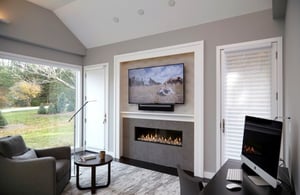
What Is a Zero Clearance Gas Fireplace?
Most contemporary fireplaces need a buffer zone or a clearance area—they must not sit in or around any combustible materials or they may give off enough heat to spark a fire. Zero-clearance fireplaces are an exception. They feature fireboxes made of materials (primarily metal) that reduce temperature buildup. Since they don’t heat up the surrounding area, it’s possible to place them close to combustible materials, such as walls or wood.
Smaller, More Versatile, and More Efficient
People choose zero-clearance fireplaces for many reasons. Because there’s no risk of a runaway blaze, they offer greater versatility. You can place them in rooms and in walls that won’t accommodate traditional fireplaces.
They also tend to take up less space. Without the need for a hearth and other complex masonry accouterments, these pre-fabricated fireplaces leave a smaller footprint. That makes them ideal for a range of non-traditional spaces, from small apartments to wood cabins. It also makes them easier to install, particularly for homeowners who are adding a fireplace to an existing structure. Finally, zero-clearance units usually run more efficiently, which means less wasted heat and energy.
What They Don’t Tell You About Zero-Clearance Fireplaces
There are many zero-clearance fireplaces on the market but not all are created equal. While all of these heat-saving units reduce the temperature enough to prevent a conflagration, most do not reduce the temperature enough to prevent damage to surrounding surfaces and other nearby objects.
Unfortunately, the high heats generated by most zero-clearance units (sometimes reaching 380 degrees) can still:
- Distort a wall surface
- Peel or discolor paint
- Melt adhesives, causing tiles to fall off the wall
- Cause wood paneling to pucker, bend, or splinter
- Crack marble surfaces
- Damage electrical components
For most conscientious property owners, such expensive damage is unacceptable. In some cases, the excessive temperatures preclude common living arrangements. Homeowners who want to place their TVs above their fireplaces, for example, will often find themselves out of luck, unless they want to risk electrical damage.
Ortal’s Cool Wall Technology
 Ortal’s modern fireplaces aren’t your average zero-clearance units. Ortal uses Cool Wall Technology, which reduces heat buildup even more than traditional zero-clearance units. Unlike cheaper fireplaces, they keep the wall above the fireplace cool. In fact, Ortal fireplaces are the only ones on the market that significantly reduce temperatures above the unit.
Ortal’s modern fireplaces aren’t your average zero-clearance units. Ortal uses Cool Wall Technology, which reduces heat buildup even more than traditional zero-clearance units. Unlike cheaper fireplaces, they keep the wall above the fireplace cool. In fact, Ortal fireplaces are the only ones on the market that significantly reduce temperatures above the unit.
Gauge the temperature zero to six inches above most zero-clearance fireplaces, and you’ll get a reading somewhere on the order of 280 to 380 degrees. Measure the temperature six to 12 inches up the wall, and you’ll still run into temperatures equaling about 240 to 320 degrees. Compare that to Ortal’s Cool Wall Technology, which reduces the temperature by more than 100 degrees, without the use of a noisy and energy-sapping fan.
The advantages are clear. You can place a TV above an Ortal fireplace without worrying about the integrity of the electronics. You can hang valuable artwork. You can use a wider variety of finish materials such as Venetian plaster paint or even wood. You can stop stressing over the inevitable damage inflicted by most zero-clearance direct vent gas fireplaces. In other words, you can enjoy your crackling fire without the hassle, the worry, or the limitations.
Explore our gallery and catalog to learn more about the advantages of Ortal’s modern fireplaces.

